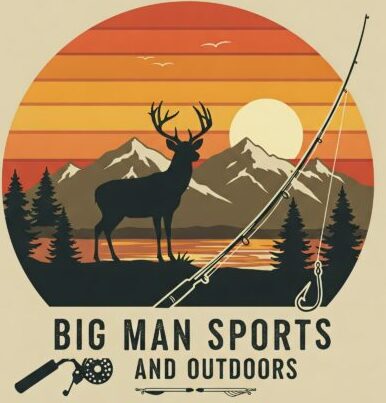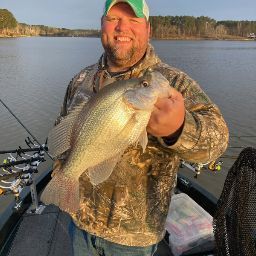Late summer, August-September can be a tough time of year to catch crappie, but if it were easy everyone would be out there, right? It’s also the time of year you pretty much have the lake to yourself. Kids are back in school, during the week of course, and it’s just too hot for the average crappie fisherman to be on the water. This is where dedicated fishermen can separate themselves as anglers. With a little bit of information such as technique, time of day, water temperature, and bait selection we can be successful on those hot late summer days. As a disclaimer, this is not the only way to be productive on the water it’s just the way I do it.
Use Your Electronics
Most days I spend more time scanning with my thermocline in the lake you will need to factor that in as well.
I will begin checking ledges, points, saddles, and creek channels for structure with sidescan. It can be brush, rocks, or laydowns, but mark everything you see, and I mean everything, with a waypoint. Your unit can save thousands of waypoints, so mark everything, turn around, and ride over it with your downscan to confirm if its structure holding fish.
Crappie stack vertically, so look for small round dots that are vertically stacked in groups of 4 or more.
Once you have determined the structure is holding fish, use a marker buoy to mark it.
Techniques of the Trade
Pulling Crank Baits For Crappie
Pulling crankbaits on those hot summer days is a fantastic way to trigger a bite from lethargic crappie. I go with the ACC Crappie Stix 18’ and 16’ trolling rods and the 13’ jigging rod. Although the jigging rod is intended for vertical jigging it has the backbone to pull the crankbaits. Typically, I pull six poles out of the back of my boat when fishing by myself. I like vicious 4lb mono with a 2oz inline sinker tied 18 to 24 inches from the crankbait. That allows me to get the bait down without having to let a ton of line out and I don’t like using planer boards. They are a lot of work and can get expensive if you lose them.
I just fan my poles out and let the length of the pole separate the baits, and it has worked for me for the last 15 years. I don’t use line counter reels either, though it would probably be easier, I will pull up shallow and watch for the baits to dig the bottom and look at my electronics to see how deep I am. That lets me know how deep the baits are running. Normally I try to run them at 14 to 18ft to catch the fish that are suspended in open water on the creek channels and ledges but don’t ignore any brush you might see as well.
Be ready to get hung and lose some baits, it’s just part of it. I like the Arkie 220 crankbaits they’re just as good as the Bandit but half the price.
Casting and Deadsticking
Once I find the brush we discussed previously and mark it I begin to fan cast and let the jig fall and reel slowly. A 1/16oz jig will fall one foot per second, so just count until you get into the depth you saw the fish stacked in the brush. I use an ACC Crappie Stix 6’6” pole, 12lb reaction tackle braid, and a bonehead tackle stump bug when casting.
Deadsticking is a little different in that the pole is twice as long and you drop the bait straight down as opposed to casting it. I like the ACC Crappie Stix 13’ pole in either the cork or winn grip, the 12lb reaction tackle braid, and the bonehead stump bug. I use the length of the pole to determine the depth by pulling off enough line to reach the bottom of the pole, I know that will be 13ft. I start with that and can go shallower or deeper depending on where the fish are in the water column. When dropping into the brush hold the jig as still as possible, too much movement can spook the fish. Move around the structure dropping for 10 seconds then move on.
Dock Shooting
When dock shooting it’s hard to beat the ACC Crappie Stix 6’ dock shooter. It’s a one-piece rod with a backbone and fast tip. I only use vicious 4lb mono hi-vis line when dock shooting.
Braid doesn’t allow me to shoot as deep under the dock as mono. Again, I use a stump bug on a 1/16 or 1/32oz jig head. If I want a slower fall, I will use the 1/32oz. It’s important to use the hi-vis line, in most cases they will hit the bait on the downfall, and you need to be able to see the line jump. The technique for this style is to reel the bait up to the first eye past the reel, grab the hook with your thumb and forefinger, pull the bait to the end of the handle, and simultaneously let go of the hook and line, shooting the bait as far under the dock as possible. Then let the bait fall and begin to reel slowly. Work every angle of the dock you can. Dock shooting takes a lot of practice to get the hang of but once you do, it is one of the best ways to catch summertime crappie.
In the summer I like to fish first thing in the morning or in the evening when the sun is low. Fish can be caught in the middle of the day but not consistently in my opinion. I get miserable baking in the sun so I’m sure the fish feel the same way. Overcast days and dark water are also things to consider.
I’m more productive on days with less sun, and darker water allows some relief from the sun for the fish.
Another important thing to keep in mind is, don’t spend too long in one area. Even if you mark fish, it doesn’t mean they will bite. One thing is certain, there are active fish in that lake somewhere, you just have to be patient and find them.
Conclusion
Mastering the art of catching summertime crappie is rewarding and demands a mixed bag of knowledge, strategy, and adaptability. As the temperatures rise and the sun casts its warm glow on the waters, crappie behavior undergoes a shift that requires anglers to tailor their approach. Throughout the summer months, several key takeaways emerge to enhance your success on the water.
Understanding the nuances of crappie behavior during this season is paramount. As the fish move deeper to find cooler, more comfortable water temperatures, adjusting your gear and technique becomes essential. Opting for lighter lines, sensitive rods, and versatile reels allows you to feel even the subtlest nibble, translating into more successful hooksets.
Equally significant is the selection of baits that mimic the movement of their primary prey, such as small minnows and insects. While live bait remains effective, artificial lures like jigs and soft plastics, presented with a deliberate yet enticing motion, can be equally productive. Moreover, exploring the potential of weed beds, submerged structures, and drop-offs—crucial hiding spots for crappie seeking refuge from the heat—can lead to remarkable catches.
Patience, a hallmark of successful anglers, proves its worth during the summer. With crappie’s potentially sporadic feeding patterns, persistence and adaptability become valuable traits. Employing a mix of techniques, from slow retrieves to subtle twitches, can trigger strikes even from lethargic fish. Furthermore, keeping a keen eye on weather patterns, water clarity, and moon phases adds an extra layer of insight to your approach.
Engaging in the summertime pursuit of crappie requires a blend of scientific understanding and intuitive finesse. As the days stretch and the sun dances on the water’s surface, anglers armed with knowledge and a willingness to experiment can unlock the secrets to consistent catches. Remember, each fishing day offers a new lesson, a fresh opportunity to refine your approach and deepen your connection with these elusive and captivating fish. So, venture forth with determination, armed with your gear, your insights, and an unwavering enthusiasm for the thrill of summertime crappie fishing.

